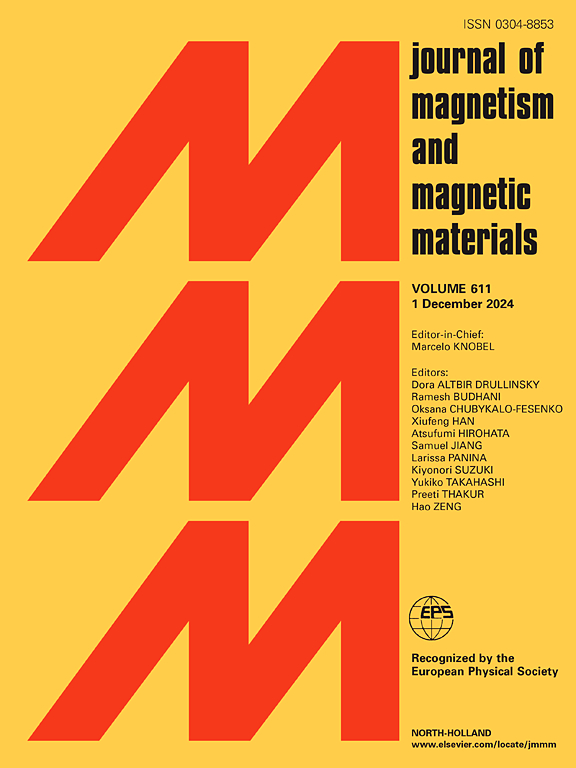通过匹配电磁特性改善CoFe2O4/AC纳米复合材料的微波吸收性能
IF 2.5
3区 材料科学
Q3 MATERIALS SCIENCE, MULTIDISCIPLINARY
引用次数: 0
摘要
为了消除微波对安全和健康的影响,开发具有强、薄、轻、宽特性的微波吸收材料显得尤为重要。本文将磁性CoFe2O4纳米颗粒引入椰子活性炭(AC)的孔隙中,形成CoFe2O4/AC纳米复合材料。比表面积和饱和磁化强度均随AC含量的增加而减小,证实了CoFe2O4纳米颗粒在AC孔隙中的存在。由于阻抗匹配,CoFe2O4/AC纳米复合材料的微波吸收性能得到了极大的提高。其中,S-8 (AC:CoFe2O4的摩尔比= 8:1)在厚度为5.5 mm时的最小反射损耗(RLmin)为- 42.99 dB,有效吸收带宽(EAB)为0.96 GHz。此外,S-12在1.5 mm处的RLmin为- 24.00 dB, EAB为3.44 GHz。CoFe2O4/AC纳米复合材料优异的微波吸收性能可归因于介电损耗、磁损耗和阻抗匹配机制的协同作用。这些机制包括界面极化、偶极极化、德拜弛豫、自然损耗、传导损耗、涡流损耗以及多重反射和散射效应。本文章由计算机程序翻译,如有差异,请以英文原文为准。
Improved microwave absorption properties of CoFe2O4/AC nanocomposites from matching electromagnetic characteristics
In order to eliminate the impact of microwaves on safety and health, the development of microwave absorption materials with strong, thin, light and broad characteristic is particularly important. In this paper, magnetic CoFe2O4 nanoparticles are introduced into the pores of coconut activated carbon (AC) to form CoFe2O4/AC nanocomposites. The specific surface area and saturation magnetization both decease with the increasing AC content, confirming the existence of CoFe2O4 nanoparticles in AC pores. The microwave absorption performance of CoFe2O4/AC nanocomposites are all greatly enhanced due to impedance matching. Specifically, S-8 (The molar ratio of AC:CoFe2O4 = 8:1) demonstrates a remarkable minimum reflection loss (RLmin) of −42.99 dB and an effective absorption bandwidth (EAB) of 0.96 GHz at a thickness of 5.5 mm. Moreover, S-12 exhibits an RLmin of −24.00 dB and a broader EAB of 3.44 GHz at 1.5 mm. The exceptional microwave absorption performance of the CoFe2O4/AC nanocomposites can be attributed to a synergy of dielectric loss, magnetic loss, and impedance matching mechanisms. These mechanisms encompass interface polarization, dipole polarization, Debye relaxation, natural loss, conduction loss, eddy current loss, as well as multiple reflection and scattering effects.
求助全文
通过发布文献求助,成功后即可免费获取论文全文。
去求助
来源期刊

Journal of Magnetism and Magnetic Materials
物理-材料科学:综合
CiteScore
5.30
自引率
11.10%
发文量
1149
审稿时长
59 days
期刊介绍:
The Journal of Magnetism and Magnetic Materials provides an important forum for the disclosure and discussion of original contributions covering the whole spectrum of topics, from basic magnetism to the technology and applications of magnetic materials. The journal encourages greater interaction between the basic and applied sub-disciplines of magnetism with comprehensive review articles, in addition to full-length contributions. In addition, other categories of contributions are welcome, including Critical Focused issues, Current Perspectives and Outreach to the General Public.
Main Categories:
Full-length articles:
Technically original research documents that report results of value to the communities that comprise the journal audience. The link between chemical, structural and microstructural properties on the one hand and magnetic properties on the other hand are encouraged.
In addition to general topics covering all areas of magnetism and magnetic materials, the full-length articles also include three sub-sections, focusing on Nanomagnetism, Spintronics and Applications.
The sub-section on Nanomagnetism contains articles on magnetic nanoparticles, nanowires, thin films, 2D materials and other nanoscale magnetic materials and their applications.
The sub-section on Spintronics contains articles on magnetoresistance, magnetoimpedance, magneto-optical phenomena, Micro-Electro-Mechanical Systems (MEMS), and other topics related to spin current control and magneto-transport phenomena. The sub-section on Applications display papers that focus on applications of magnetic materials. The applications need to show a connection to magnetism.
Review articles:
Review articles organize, clarify, and summarize existing major works in the areas covered by the Journal and provide comprehensive citations to the full spectrum of relevant literature.
 求助内容:
求助内容: 应助结果提醒方式:
应助结果提醒方式:


